Carrera del Darro in Granada – a Place that Seem to Be from Another Time
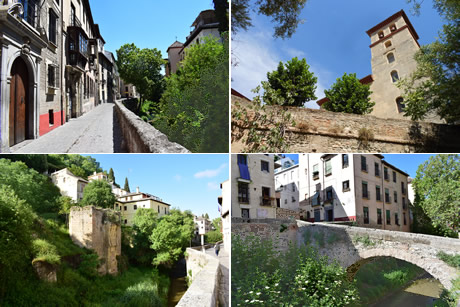
Carrera del Darro is the name of the street that runs along the left bank of the Darro River in Granada, extending from Plaza Nueva to the Casa de las Chirimías, where the Paseo de los Tristes begins.
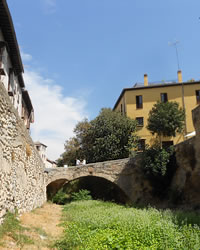
Enjoy a special day at the Alhambra with a guided tour
 Alhambra and Nasrid Palaces: discover the wonders of the Alhambra with this all-inclusive tour: the Nasrid Palaces, the Generalife, the Alcazaba, and more.
Alhambra and Nasrid Palaces: discover the wonders of the Alhambra with this all-inclusive tour: the Nasrid Palaces, the Generalife, the Alcazaba, and more.
 Alhambra + Albaicín + Sacromonte: a perfect combination of a guided tour of the Alhambra in the morning and a guided tour of the Albaicin and Sacromonte in the afternoon.
Alhambra + Albaicín + Sacromonte: a perfect combination of a guided tour of the Alhambra in the morning and a guided tour of the Albaicin and Sacromonte in the afternoon.La Carrera del Darro is one of the most beautiful walks in Granada and has changed the least over time. It should not be confused with the Acera del Darro, which is located in Puerta Real.
In this area, we walk alongside the Darro River along a narrow cobblestone street, with picturesque brick and stone bridges.
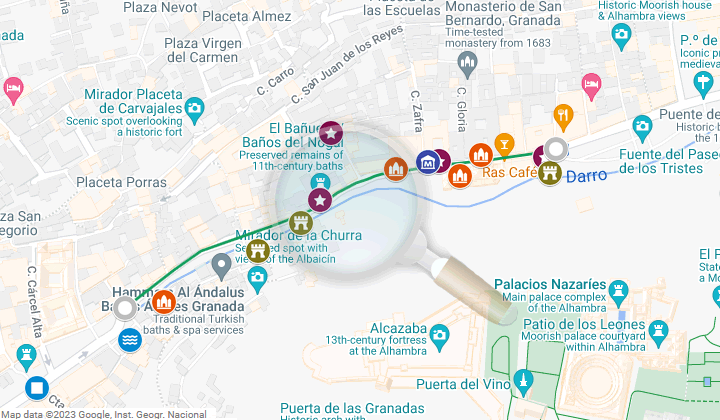
They are the Puente de Cabrera and the Puente de Espinosa, both dating back to the early 17th century.
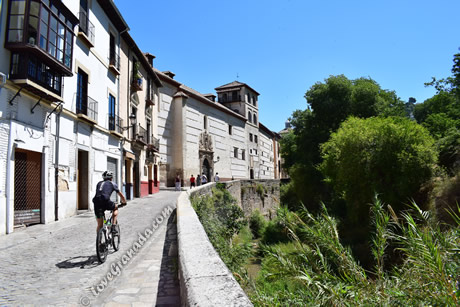 On the right, as we look up at Sabika hill, we contemplate the majestic and secretive
the Alhambra, surrounded by vegetation.
On the right, as we look up at Sabika hill, we contemplate the majestic and secretive
the Alhambra, surrounded by vegetation.
From the beginning of the Carrera del Darro we can see the Torre de la Vela and the Torre del Cubo, which is part of the Alcazaba.
A little further on, as we reach the Paseo de los Tristes, we see the Comares Tower, the highest in the Alhambra, and part of the Nasrid Palaces.
The Bridges of the Darro River
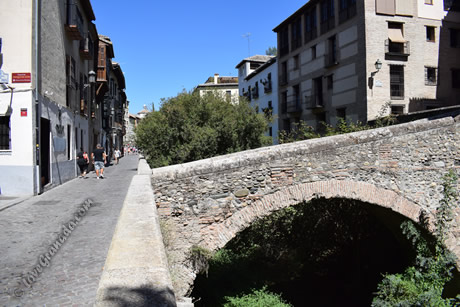 The Cabrera and Espinosa bridges connect the Acera del Darro with the Churra neighborhood, situated
between the Darro River and the Alhambra Forest,
and Almanzora ravine, which extended to the Gomérez slope.
The Cabrera and Espinosa bridges connect the Acera del Darro with the Churra neighborhood, situated
between the Darro River and the Alhambra Forest,
and Almanzora ravine, which extended to the Gomérez slope.
These bridges have reached our days almost intact, despite the transformation that the Carrera del Darro underwent in the seventeenth century.
We have not been so fortunate with the vanished Puente del Cadí or Puerta de los Tableros, which since the eleventh century connected the the Alhambra with the Albaicín.
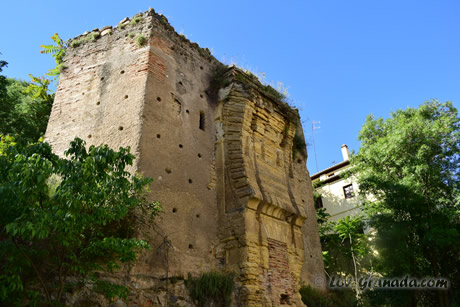 About 200 meters from the Espinosa Bridge we can see the remains of the horseshoe arch where it once stood,
as well as the hexagonal tower that linked with the wall of the Alhambra.
About 200 meters from the Espinosa Bridge we can see the remains of the horseshoe arch where it once stood,
as well as the hexagonal tower that linked with the wall of the Alhambra.
On the other side of the river, there was another similar tower, linking, in this case, with the wall of the Albaicín citadel.
Almost all of the bridges that crossed the Darro River have now disappeared.
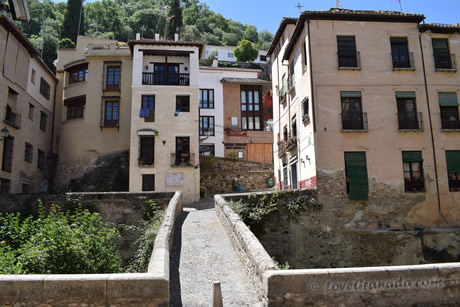 In 1509 the blowing up of a powder magazine next to the Church of Saint Peter and Saint Paul caused numerous
destruction and demolished part of the wall.
In 1509 the blowing up of a powder magazine next to the Church of Saint Peter and Saint Paul caused numerous
destruction and demolished part of the wall.
The direction of the riverbed was then modified and the street was widened.
The works of the vaulting of the Darro river from Plaza Nueva destroyed the remaining bridges.
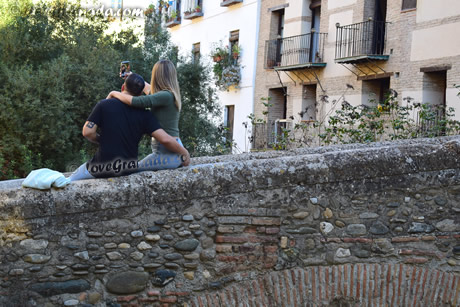
Arab Houses and Baths, Convents and Palaces
Numerous and interesting buildings from the 16th and 17th centuries are preserved in Granada's Carrera del Darro, along with remains of Arab housesfrom the the Nasrid period.On your walk, you will encounter old convents, palatial houses, churches, and historical buildings of great importance.
If you have time, do visit them; if not, simply contemplate their wonderful facades.
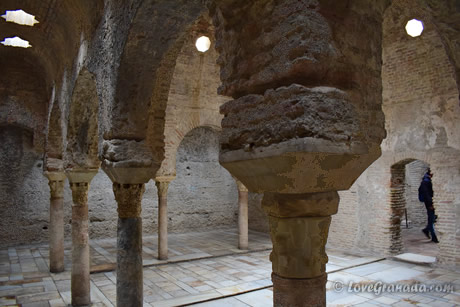 Shortly after passing the Espinosa bridge, at the height of the Cadí Bridge or Puerta de Tableros,
you'll find El Bañuelo.
Shortly after passing the Espinosa bridge, at the height of the Cadí Bridge or Puerta de Tableros,
you'll find El Bañuelo.
These Arab baths are among the best-preserved in Spain and represent one of Granada's oldest monuments, dating back to the 11th century.
From the exterior, one would never anticipate the grandeur contained within this building, especially as entry is gained through a house constructed above it.
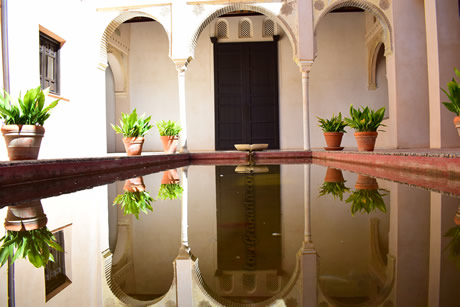 As we proceed, the street widens slightly until we arrive at the Convent of Santa Catalina de Zafra,
adorned with a Renaissance facade and a white stone doorway.
As we proceed, the street widens slightly until we arrive at the Convent of Santa Catalina de Zafra,
adorned with a Renaissance facade and a white stone doorway.
Inside, we'll encounter a sculpture of Saint Catherine of Siena along with the family crests of Don Hernando de Zafra, the Catholic Monarchs's secretary.
In this instance, the façade itself speaks volumes about the importance of this place.
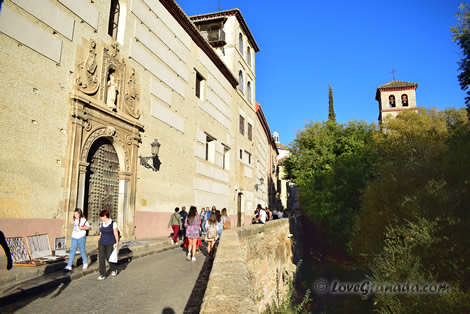 The church consists of a collection of houses donated by the Zafra family, one of which is the beautiful
House of Zafra, a 14th-century Arab residence in excellent condition.
The church consists of a collection of houses donated by the Zafra family, one of which is the beautiful
House of Zafra, a 14th-century Arab residence in excellent condition.
The Casa de Ruana now serves as the Interpretation Center of the Albaicín, providing yet another reason to visit. However, above all, it's worth seeing as one of the rare examples of domestic architecture from the Nasrid period that still exist in Granada.
The entrance is situated on a small street known as Portería de Zafra, adjacent to the Convent.
Make your experience in Granada even more complete and memorable
10 Best Caves and Venues for Flamenco in Granada: immerse yourself in the passion of flamenco and live unique experiences in the best tablaos in the city.
Authentic Arab Baths and Relaxing Massage: enjoy a deep relaxation experience with an exclusive massage in a traditional setting.
The House of Castril and the Archaeological Museum
If we continue along the same sidewalk, in the next block we encounter the Casa de Castril, a Renaissance palace brimming with history. It was constructed in 1539 and it is believed that the Plateresque-style facade is the handiwork of Diego de Siloé.
It was constructed in 1539 and it is believed that the Plateresque-style facade is the handiwork of Diego de Siloé.
This mansion served as the residence of Don Hernando de Zafra and his successors, who held the title of Lords of Castril.
The Comares Tower is depicted on the lintel of the door, featuring a coat of arms granted to them by the Catholic Monarchs.
 Inside, visitors can appreciate the beautiful patio, characteristic of Granada houses
from this era, as well as stunning views of the Alhambra from the upper floor.
Inside, visitors can appreciate the beautiful patio, characteristic of Granada houses
from this era, as well as stunning views of the Alhambra from the upper floor.
The House of Castril has served as the headquarters of the Archaeological Museum of Granada since 1923 and contains artifacts from archaeological sites across the province.
It stands as one of the oldest museums in Spain.
The Church of Saint Peter and Saint Paul
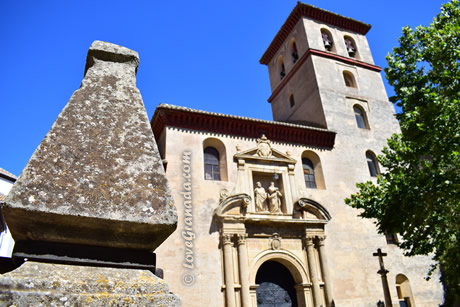 Directly across from the museum, adjacent to the river, you'll notice a small square enclosed by a gate.
This is the Church of Saint Peter and Saint Paul, one of the oldest in Granada.
Directly across from the museum, adjacent to the river, you'll notice a small square enclosed by a gate.
This is the Church of Saint Peter and Saint Paul, one of the oldest in Granada.
The church was constructed in 1501 upon the site of an ancient aljama known as the Baths Mosque, of which only a few foundations and walls still endure.
The original church was demolished in 1559 and the current one was designed by Juan de Maeda, a prominent disciple of Diego de Siloé, in 1560.
 The church features a beautiful side doorway crafted by Juan de Maeda, as well as a larger one overlooking
the square at the main entrance. The latter, representing Saint Peter and Saint Paul, the titular saint,
is the work of Pedro de Orea.
The church features a beautiful side doorway crafted by Juan de Maeda, as well as a larger one overlooking
the square at the main entrance. The latter, representing Saint Peter and Saint Paul, the titular saint,
is the work of Pedro de Orea.
Within the Renaissance-style church, a stunning Mudéjar coffered ceiling is preserved, alongside several works of great artistic value, including imagery by Pedro de Mena, Pablo de Rojas, José de Mora and Pedro Machuca and a Flemish panel from the 16th century.
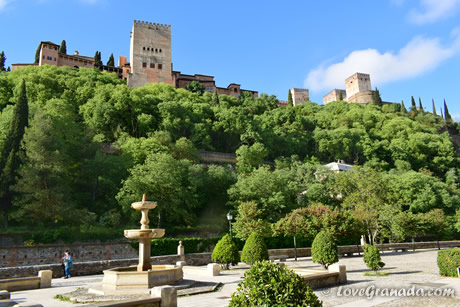 At the end of Carrera del Darro is the Casa de las Chirimias.
At the end of Carrera del Darro is the Casa de las Chirimias.
Paseo de los Tristes
Further up the street, it broadens into a sizable square dominated by a truly impressive view of the Alhambra. It is the Paseo de los Tristes.>How to Get to the Darro Race
You can get to Carrera del Darro on foot from Plaza Nueva or by bus number C31, C32 and C34. The bus stop is called 'Paseo de los Tristes'.You can also take any bus heading to the Cathedral (4, 8, 11, 21, 33) and then it's just a 2-minute walk.
Page Updated: Jul 14, 2025
Was this useful? Been to these sights? Share your thoughts!
© Copyright •
LoveGranada.com • Any use of the content, including copying of it in whole or in part is prohibited.
You Might Also Be Interested In
Opinions about Carrera del Darro in Granada
Nice summer nights
Amazing views, specially at night when the churches along the way are illuminated, and the Alhambra on the top of the hill shines beautifully. We were there on a summer night and the experience was very pleasant. The only place in the city where we could dodge the heat. At the restaurant & bar terraces by the river you can feel the cool air of the place.

